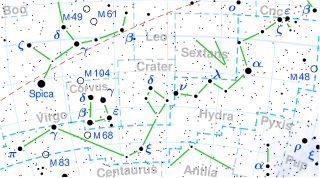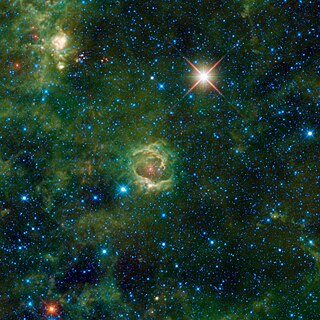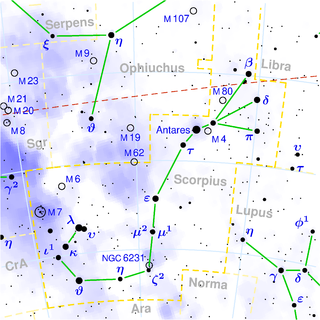Related Research Articles

Mira variables are a class of pulsating stars characterized by very red colours, pulsation periods longer than 100 days, and amplitudes greater than one magnitude in infrared and 2.5 magnitude at visual wavelengths. They are red giants in the very late stages of stellar evolution, on the asymptotic giant branch (AGB), that will expel their outer envelopes as planetary nebulae and become white dwarfs within a few million years.

The asymptotic giant branch (AGB) is a region of the Hertzsprung–Russell diagram populated by evolved cool luminous stars. This is a period of stellar evolution undertaken by all low- to intermediate-mass stars late in their lives.

S Persei is a red supergiant or hypergiant located near the Double Cluster in Perseus, north of the cluster NGC 869. It is a member of the Perseus OB1 association and one of the largest known stars. If placed in our solar system, its photospehere would engulf the orbit of Jupiter. It is also a semiregular variable, a star whose variations are less regular than those of Mira variables.
TX Camelopardalis is a Mira-type variable star in the constellation Camelopardalis. It is a classical long period variable star with pulsational period of 558.7 days. Water masers have been observed around the star.

VX Sagittarii is an extreme asymptotic giant branch star located more than 1.5 kiloparsec away from the Sun in the constellation of Sagittarius. It is a pulsating variable star with an unusually large magnitude range. It is also one of the largest stars discovered so far, with a radius varying between 1,350 and 1,940 solar radii (940,000,000 and 1.35×109 km; 6.3 and 9.0 au). It is the most luminous known AGB star, at bolometric magnitude –8.6, which is even brighter than the theoretical limit at –8.0.
W Hydrae is a Mira-type variable star in the constellation Hydra. The star is nearly located within the Solar neighborhood, between 75 and 120 parsecs, likely at 320 light years from the Sun. It has a visual apparent magnitude range of 5.6 to 10. In the near-infrared J band it has a magnitude of -1.7, is the 7th brightest star in the night sky, and is even brighter than Sirius.

V Hydrae is a carbon star in the constellation Hydra. To date perhaps uniquely in our galaxy it has plasma ejections/eruptions on a grand scale every 8.5 years caused by its near, unseen companion in an 8.5 year orbit, inferred by its ultraviolet excess and periastron passage likely through the outer parts of the star itself.

RSGC1 is a young massive open cluster in the Milky Way galaxy. It was discovered in 2006 in the data generated by several infrared surveys, named for the unprecedented number of red supergiant members. The cluster is located in the constellation Scutum at the distance of about 6.6 kpc from the Sun. It is likely situated at the intersection of the northern end of the Long Bar of the Milky Way and the inner portion of the Scutum–Centaurus Arm—one of its two major spiral arms.

RT Carinae, also known as CD-58 3538, is a variable star in the Carina Nebula in the constellation Carina. It has a mean apparent magnitude of +8.55.
U Equulei is a variable star in the Equuleus constellation with an apparent magnitude of +14.50 in the B band. It lies at an estimated distance of 5,000 light-years from the Solar System.

PZ Cassiopeiae is a red supergiant star located in the Cassiopeia constellation, and a semi-regular variable star.
Y Centauri or Y Cen is a semiregular variable star in the constellation of Centaurus.

Westerlund 1-26 or Wd 1-26 is a red supergiant within the outskirts of the Westerlund 1 super star cluster. It is one of the largest known stars discovered so far although its radius is uncertain but is calculated to be 1,165–1,221 solar radii (810,000,000–849,000,000 km; 5.42–5.68 au), with a possible but very unlikely upper estimate of 2,519 solar radii (1.752×109 km; 11.71 au), corresponding to a volume between 1.58 and 16 billion times bigger than the Sun. Assuming the upper estimate is correct, if placed at the center of the Solar System, its photosphere would engulf the orbit of Jupiter.

AH Scorpii is a red supergiant variable star located in the constellation Scorpius. It is one of the largest stars known by radius and is also one of the most luminous red supergiant stars in the Milky Way.

IRC -10414 is a red supergiant and runaway star in the constellation Scutum, a rare case of a red supergiant with a bow shock.

XX Persei is a semiregular variable red supergiant star in the constellation Perseus, between the Double Cluster and the border with Andromeda.
IK Tauri or NML Tauri is a Mira variable star located about 280 parsecs (910 ly) from the Sun in the zodiac constellation of Taurus.

Stephenson 2-18 (St2-18), also known as Stephenson 2 DFK 1 or RSGC2-18, is a red supergiant star in the constellation of Scutum. It lies near the open cluster Stephenson 2, which is located about 6,000 parsecs away from Earth, and is assumed to be one of a group of stars at a similar distance. It is among the largest known stars, and one of the most luminous red supergiants, with an estimated radius around 2,150 times that of the Sun (R☉), which corresponds to a volume nearly 10 billion times bigger than the Sun. If placed at the center of the Solar System, its photosphere would engulf the orbit of Saturn.

Westerlund 1-237 or Wd 1-237 is a possible red supergiant (RSG) in the constellation of Ara. It is one out of 4 known red supergiants in the Westerlund 1 super star cluster, although its outlying position, spectrum, and parallax, suggest it could be a foreground giant. As a red supergiant, it would be one of the largest known stars and one of most luminous of its type.

Westerlund 1-75 or Wd 1-75 is a red supergiant (RSG) located in the Westerlund 1 super star cluster. Its radius was calculated to be around 668 solar radii (4.65 × 108 km, 3.10 au). This corresponds to a volume 298 million times bigger than the Sun. If placed at the center of the Solar System, Westerlund 1-75 would engulf the inner limits of the asteroid belt.
References
- 1 2 Spitzer Science, Center (2009). "VizieR Online Data Catalog: GLIMPSE Source Catalog (I + II + 3D) (IPAC 2008)". VizieR On-line Data Catalog. Bibcode:2009yCat.2293....0S.
- 1 2 3 Tafoya, Daniel; Imai, Hiroshi; Gómez, José F.; Nakashima, Jun-Ichi; Orosz, Gabor; Yung, Bosco H. K. (2020). "Shaping the Envelope of the Asymptotic Giant Branch Star W43A with a Collimated Fast Jet". The Astrophysical Journal. 890 (1): L14. arXiv: 2006.07157 . Bibcode:2020ApJ...890L..14T. doi:10.3847/2041-8213/ab70b8. S2CID 213655593.
- ↑ Vickers, Shane B.; Frew, David J.; Parker, Quentin A.; Bojičić, Ivan S. (2015). "New light on Galactic post-asymptotic giant branch stars - I. First distance catalogue". Monthly Notices of the Royal Astronomical Society. 447 (2): 1673. arXiv: 1403.7230 . Bibcode:2015MNRAS.447.1673V. doi:10.1093/mnras/stu2383. S2CID 119245776.
- ↑ Vlemmings, Wouter H.T.; Diamond, Philip J.; Imai, Hirosh (2006). "A magnetically collimated jet from an evolved star". Nature. 440 (7080): 58–60. arXiv: astro-ph/0603003 . Bibcode:2006Natur.440...58V. doi:10.1038/nature04466. PMID 16511488. S2CID 1899909.